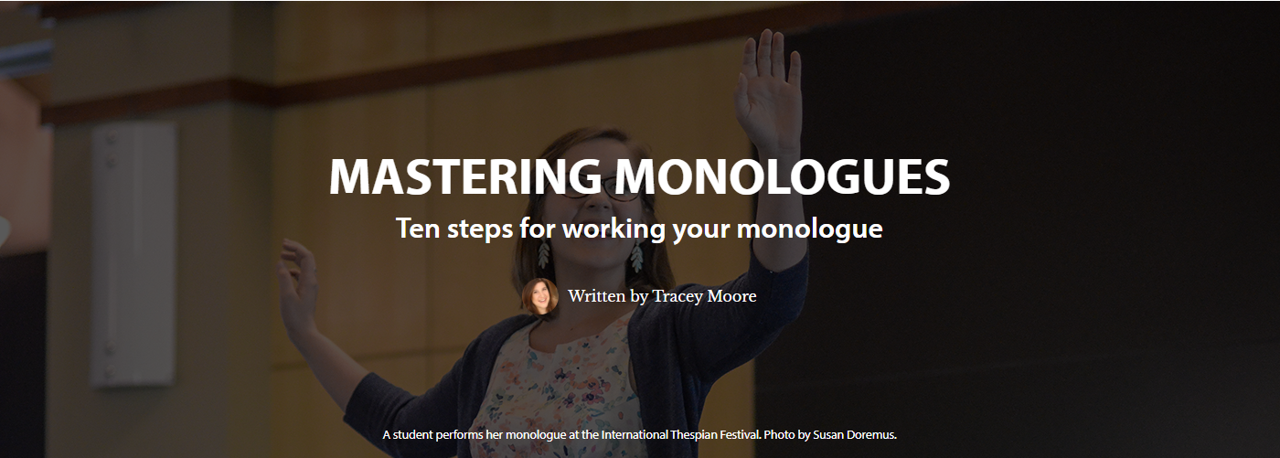
Click to Teach/Click to Learn: Learning about Performance with a Thespy
For this unit of instruction, students will be guided through the process of preparing a video of a monologue or song performance suitable for EdTA's International Thespian Excellence Awards, or the Thespys®. This unit is a great addition to any theatre curriculum, and provides resources for students preparing for competitions, college auditions, and more.
Learning Goals:
- The student will understand the steps required to prepare a video taped performance for an educational competition.
- The student will apply performance skills to the creation of a brief video designed to showcase their strengths and theatre learning.
- The student will reflect on the connection between adjudicated performance opportunities and theatre learning.
Step 1: Get Inspired
Get inspired by this performance by Anjali Raghaven, which earned a Superior rating in EdTA's International Thespian Excellence Awards.
Monologue from The Curious Case of the Watson Intelligence by Madeleine George shared for educational purposes by special permission from the Gersh Agency. Monologue from Wedding Belles by Alan Bailey and Ronnie Claire Edwards shared for educational purposes by special permission from the author Alan Bailey.
Step 2: Check the Rules and Regulations
Every adjudication has guidelines concerning the materials you may use, as well as rules regarding time limits. Be sure to familiarize yourself with all of the rules and regulations before you finalize the monologue(s) and/or songs you will be performing in your submission.
For the Thespy Awards, you will need to choose performance materials that have been approved for use in the Thespys program. See the Official Thespys Program Guide for details on acceptable materials and securing performance rights. Additionally, visit this Approved Publishers webpage to see which materials are approved. Finally, make sure the materials you choose fit within the time limit and follow all the rules and requirements. See the Time Limits section of the Official Thespys Program Guide for more details.
In the article "How to Win a Thespy" on dramatics.org, author Suzanne Maguire shares the following advice about choosing materials: "After reviewing the rules, consider CONNECTION. When you connect to material, your audience will connect to you. It is that simple. It could be the subject matter, a character’s story, or the vocal range of a song. No matter how you connect, trust your gut to know what is a good fit. But getting feedback from trusted advisors like teachers, mentors, and friends about what material they might recommend for you can help you chooses wisely, too. Others often see qualities in us that we do not, and their input can lead to finding pieces we would never consider."
Step 3: Rehearse and Refine Your Performance
Now that you've chosen your song and/or monologue(s), it's time to rehearse, rehearse, rehearse!
Take the time to review the performance rubric and familiarize yourself with the criteria. For acting performances, judges are usually looking for strong characterization, and for your voice and movements to support the story of the song and/or monologue.
Go to the Official Thespys Program Guide to access the rubrics for the Solo Acting Performance and Solo Musical Theatre Performance Thespys categories.
As you are rehearsing and refining your performance, be sure to consider each one of the aspects that judges will be scoring you on. You may find it helpful to film yourself performing, and then watch the performance and score yourself on the rubric. Write down why you scored yourself that way, and use your notes to help you refine your performance. Alternatively, you can ask a teacher or a learning buddy to watch the video recording and score your performance on the rubric, and ask them for feedback. "Find people who will provide you honest and helpful feedback. Workshopping your material in front of your teacher/peers/mentors can serve to fine-tune already strong moments and help you strengthen weaker ones" (source: "How to Win a Thespy" by Suzanne Maguire on dramatics.org).
For more suggestions for rehearsing and refining performances, check out these additional Click to Teach lessons linked below. You can also click on the images to check out two articles from dramatics.org with more tips for working on monologues and songs.
- Click to Teach/Click to Learn: Preparing a Role
- Click to Teach/Click to Learn: Analyzing Text to Interpret a Role
 "Mastering Monologues - Ten steps for working your monologue" by Tracey Moore |  "On Your Own - 11 ways to sharpen your performance when your director's not around" by Joe Deer |
Step 4: Practice Slating
An important part of any submission for a competition or an audition is your slate. In your slate, you will likely be asked to provide the adjudicators with your name, the title of your piece and the name of the playwright and/or composer. For a Thespys entry, you are also asked to provide your Troupe number (See the Slating section of the Official Thespys Program Guide for the slating requirements for the Thespys program.)
Make sure you rehearse your slate, and practice transitioning from your slate into your performance.
Step 5: Dress Professionally
When you are filming a performance video for submission to a competition or as an audition, you want to make sure you are representing yourself well through your clothing. Your outfit should be professional, and not distracting in any way. Also, try to wear something that you are comfortable in, and that will allow you to move.
Check out this article to see some examples of business causal dress. The competition you are submitting to may have a specific dress code, so be sure to read any rules ahead of time. If you are interested in submitting an entry for the Thespys program, you can view the dress code here.
Step 6: Film Your Video
When creating a video submission, it is important to prepare by finding a spot to film and considering the lighting, background, and audio quality. Click on the image below to read the article "Mastering Virtual Auditions" by Natalie Clare on dramatics.org. This article contains tips about lighting, location, sound, cameras, and more.

Before you start filming, take time to go back over of the submission requirements for entries to the competition, and make sure you have covered all of the requirements. If you are interested in submitting to the Thespys program, the Submission Requirements can be found in the Official Thespys Program Guide.
Additionally, the Thespys FAQs page offers some great guidelines and tips for filming and making a performance video.
When you are ready, it's time to film your performance video!
Step 7: Reflect on the Process
Find a classmate/learning buddy who can give you feedback on your filmed performance. Ask them to watch the video, and score your performance based on the rubric. Then, ask them to provide you with some feedback and tell you why they gave the performance that score.
After receiving feedback from a learning buddy, write a journal entry that addresses the following:
- What did you feel was successful about your performance?
- What was the most challenging part of this process?
- What new discoveries did you make about acting & performance by creating your video submission?
Diving Deeper
To dive deeper, you may be able to submit your performance video to the Thespys program. Check out this webpage to find a Thespy qualifying event in your area.
Once you find your Thespy qualifier, take the time to understand the requirements in your region. Also, make sure you have read through the entire Official Thespys Program Guide to verify you understand all of the rules and requirements.
TIP: watch your video both before and after uploading to ensure it's what you want to submit, and check out the Thespys FAQs page for more tips for submitting your video.
Once you're ready, follow the steps to submit your Thespy entry!
Measuring Learning
Click on the links below to access the rubrics for the Solo Acting Performance and Solo Musical Theatre Performance categories for EdTA's International Thespian Excellence Awards, or the Thespys®:
Classroom Connections
National Theatre Standards
TH:Cr3.1.I.a. Practice and revise a devised or scripted drama/theatre work using theatrical staging conventions.
TH:Cr3.1.I.b. Explore physical, vocal and physiological choices to develop a performance that is believable, authentic, and relevant to a drama/theatre work.
TH:Pr4.1.I.a. Examine how character relationships assist in telling the story of a drama/theatre work
TH:Pr4.1.I.b. Shape character choices using given circumstances in a drama/theatre work
TH:Pr4.1.II.a. Discover how unique choices shape believable and sustainable drama/theatre work.
TH:Pr6.1.II.a. Present a drama/theatre work using creative processes that shape the production for a specific audience.
| Access Date | Quiz Result | Score | Actions |
|---|
Learning Center
- Webinars
- Adjudication Trainings
- Featured Courses
- Full Course List
- Lesson Plan Library
- Click to Teach Interactive Online Lessons
- Resources for New Theatre Teachers
- Technical Theatre Educator's Manual
- Connected Arts Networks
- Diverse Resources for Theatre Education
- Behind the Scenes Technical Theatre Curriculum
- Social & Emotional Learning
- Additional Standards Based Instructional Resources
- Search the Catalog
- Cart (0 items)
Full Site Search
Membership Benefits
Join EdTA for full access to our professional development and standards-based teaching resources, including:
- 300+ lesson plans
- Click to Teach online lessons
- K-12 curriculum
- Webinars
- And more!



